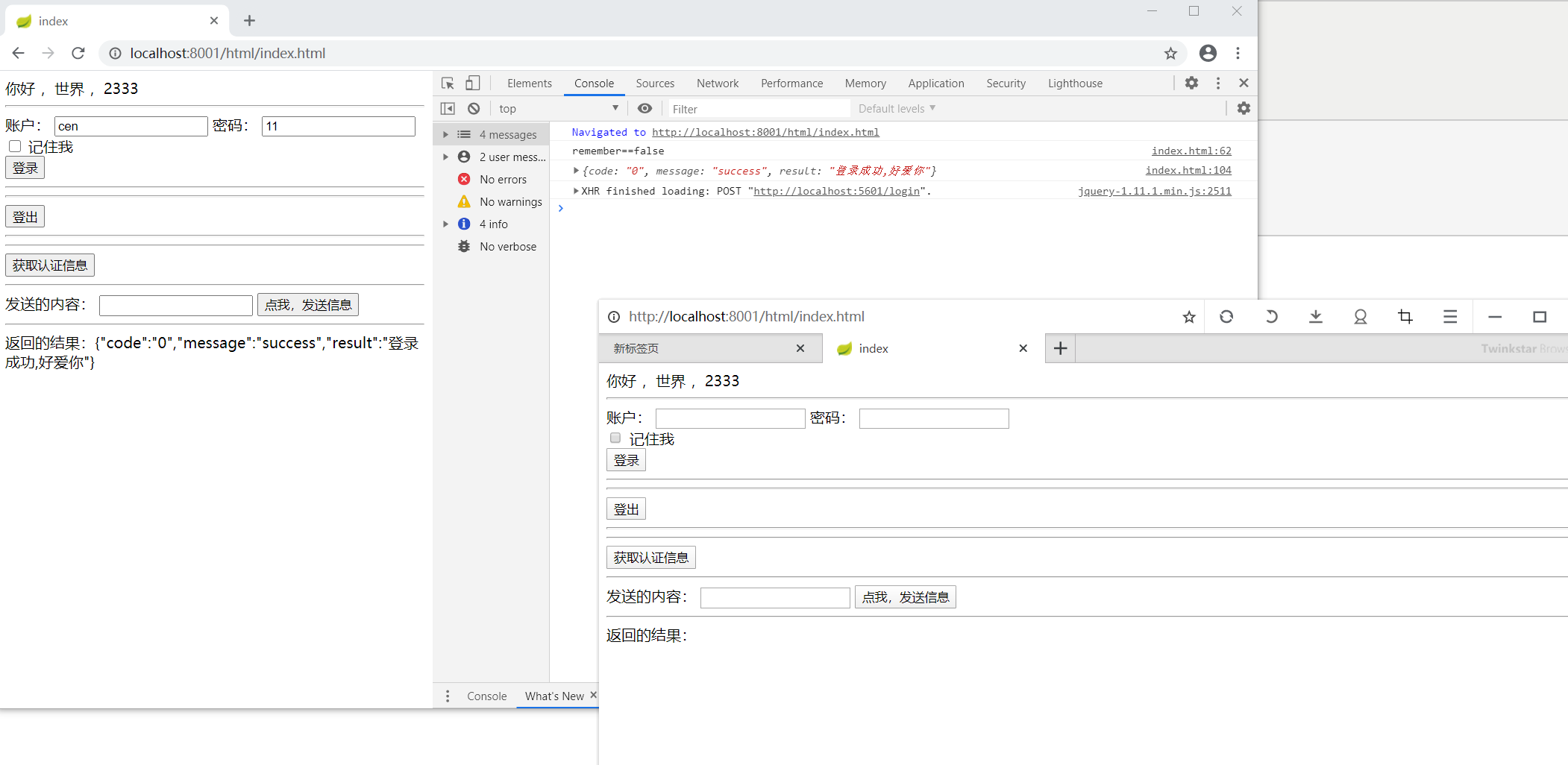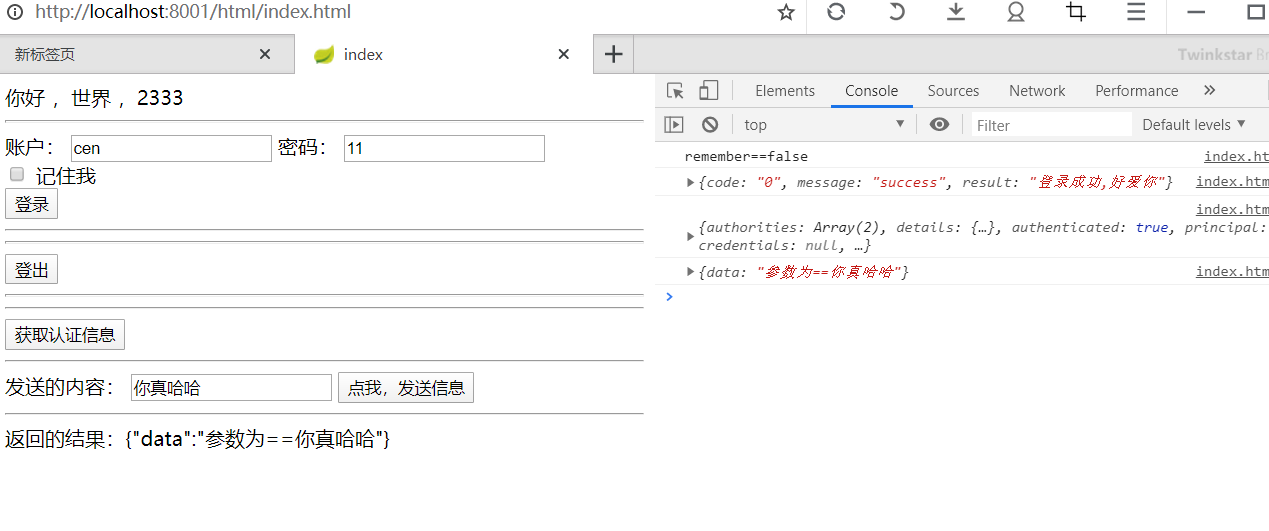1.前言
spring security 支持对session的管理 ,
http.sessionManagement().maximumSessions(1);的意思的开启session管理,session并发最多一个,超出后,
旧的session被注销,新的会注册,这种操作称为缺省实现 。
session缺省实现原理是将session记录在内存map中,因此不能用于集群环境中,会导致服务器1中记录的信息和服务器2记录的信息并不相同;
解决的方案是使用spring session ,session存在redis里面作为共享信息【具体以后的随笔会详细讲解,这里不多解释】
2.操作
使用上一随笔做的spring security前后端分离跨域的工程做测试

security完整配置

package com.example.securityqh5601.config.security; import org.springframework.beans.factory.annotation.Autowired; import org.springframework.context.annotation.Bean; import org.springframework.security.config.annotation.authentication.builders.AuthenticationManagerBuilder; import org.springframework.security.config.annotation.method.configuration.EnableGlobalMethodSecurity; import org.springframework.security.config.annotation.web.builders.HttpSecurity; import org.springframework.security.config.annotation.web.builders.WebSecurity; import org.springframework.security.config.annotation.web.configuration.WebSecurityConfigurerAdapter; import org.springframework.security.config.annotation.web.configuration.EnableWebSecurity; import org.springframework.security.core.session.SessionRegistry; import org.springframework.security.crypto.bcrypt.BCryptPasswordEncoder; import org.springframework.web.servlet.config.annotation.CorsRegistry; import org.springframework.web.servlet.config.annotation.WebMvcConfigurer; //这个加不加无所谓 //@Configuration //开启security自定义配置 @EnableWebSecurity //开启 Controller层的访问方法权限,与注解@PreAuthorize("hasRole('ROLE_admin')")配合,会拦截注解了@PreAuthrize注解的配置 // 想要@PreAuthorize正确执行 ,权限关键字必须带前缀 ROLE_ ,后面的部分可以随便写!!!!靠,琢磨了4小时了 ,终于找到原因了 @EnableGlobalMethodSecurity(prePostEnabled = true) // public class WebSecurityConfig2 extends WebSecurityConfigurerAdapter { //实例自定义登录校验接口 【内部有 数据库查询】 @Autowired private DbUserDetailsService2 dbUserDetailsService; /** * 忽略过滤的静态文件路径 */ @Override public void configure(WebSecurity web) throws Exception { web.ignoring() .antMatchers( "/js/**/*.js", "/css/**/*.css", "/img/**", "/html/**/*.html" ); } /** * 全局的跨域配置 */ @Bean public WebMvcConfigurer WebMvcConfigurer() { return new WebMvcConfigurer() { public void addCorsMappings(CorsRegistry corsRegistry) { //仅仅让/login可以跨域 corsRegistry.addMapping("/login").allowCredentials(true).allowedHeaders("*"); //仅仅让/logout可以跨域 corsRegistry.addMapping("/logout").allowCredentials(true).allowedHeaders("*"); //允许所有接口可以跨域访问 //corsRegistry.addMapping("/**").allowCredentials(true).allowedHeaders("*"); } }; } //拦截规则设置 @Override protected void configure(HttpSecurity http) throws Exception { //开启授权认证 //开启跨域共享,关闭同源策略【允许跨域】 http.cors() //跨域伪造请求=无效, .and().csrf().disable(); //配置路径拦截规则 http.authorizeRequests() // 只要有 "user","admin"任意最少一个权限即可访问路径"/user/**"的所有接口 // .antMatchers("/user/**").hasAnyAuthority("ROLE_user", "ROLE_admin") // //只有权限"admin"才可以访问"/admin/**"所有路径 和 接口 "/vip" // .antMatchers("/admin/**", "/vip").hasAuthority("ROLE_admin") //所有请求都需要验证,必须要放在antMatchers路径拦截之后,不然拦截失效 .anyRequest().authenticated(); // //路径拦截权限的名称必须与权限列表注册的一样,经过测试,方法级别的注解权限需要ROLE_前缀 ,因此, // 路径拦截权限的名称、注解权限名称、数据库存储的权限名称都要加ROLE_前缀最好,避免出现错误, // 如果数据库的权限名称不加ROLE_前缀,那么在注册权限列表的时候记得拼接ROLE_前缀 //登录配置 http.formLogin() //登录名参数 .usernameParameter("username") //密码参数 .passwordParameter("password") //post登录访问路径 .loginProcessingUrl("/login"); //登录结果处理 http.formLogin() //登录成功 .successHandler(new CustomAuthenticationSuccessHandler()) //--0 //登录失败 .failureHandler(new CustomAuthenticationFailureHandler()); //--0 //登录退出处理 http.logout() ////post登出访问路径 .logoutUrl("/logout") //成功退出处理 .logoutSuccessHandler(new CustomLogoutSuccessHandler()) //--0 //清除认证信息 .clearAuthentication(true).permitAll(); //异常抛出处理 http.exceptionHandling().authenticationEntryPoint(new CustomAuthenticationEntryPoint()) //-- 401 //访问拒绝处理【无权】 .accessDeniedHandler(new CustomAccessDeniedHandler()); //--2 //开启cookie自动登录 http.rememberMe() //自动登录成功处理//todo // .authenticationSuccessHandler(new ....) //密钥 .key("unique-and-secret") //cookie名 .rememberMeCookieName("remember-me-cookie-name") //生命周期,单位毫秒 .tokenValiditySeconds(24 * 60 * 60); //session并发管理 ,原理是其缺省实现是将session记录在内存map中,因此不能用于集群环境中,服务器1中记录的信息和服务器2记录的信息并不相同; // // Session的并发控制,这里设为最多一个,只允许一个用户登录,如果同一个账户两次登录,那么第一个账户将被踢下线 http.sessionManagement().maximumSessions(1); //当一个用户已经认证过了,在另外一个地方重新进行登录认证,spring security可以阻止其再次登录认证,从而保持原来的会话可用性 //存在一个问题,当用户登陆后,没有退出直接关闭浏览器,则再次打开浏览器时,此时浏览器的session若被删除的话,用户只能等到服务器的session过期后,才能再次登录。 // http.sessionManagement().maximumSessions(1).maxSessionsPreventsLogin(true); //默认是开通session fixation防护的.因此可以不写,防护的原理为,每当用户认证过后,就会重新生成一个新的session,并抛弃旧的session // http.sessionManagement().sessionFixation().migrateSession(); //解决不允许显示在iframe的问题 // http.headers().frameOptions().disable(); } /** * 添加 UserDetailsService, 实现自定义登录校验,数据库查询 */ @Override protected void configure(AuthenticationManagerBuilder builder) throws Exception { //注入用户信息,每次登录都会来这查询一次信息,因此不建议每次都向mysql查询,应该使用redis builder.userDetailsService(dbUserDetailsService) //密码加密方式 .passwordEncoder(passwordEncoder()); } /** * BCryptPasswordEncoder相关知识: * 用户表的密码通常使用MD5等不可逆算法加密后存储,为防止彩虹表破解更会先使用一个特定的字符串(如域名)加密,然后再使用一个随机的salt(盐值)加密。 * 特定字符串是程序代码中固定的,salt是每个密码单独随机,一般给用户表加一个字段单独存储,比较麻烦。 * BCrypt算法将salt随机并混入最终加密后的密码,验证时也无需单独提供之前的salt,从而无需单独处理salt问题。 */ @Bean public BCryptPasswordEncoder passwordEncoder() { return new BCryptPasswordEncoder(); } } //参考 博文原址 //https://www.dazhuanlan.com/2019/10/01/5d92e281abbc4/ //https://www.cnblogs.com/guos/archive/2019/10/02/11617243.html //https://blog.csdn.net/icarusliu/article/details/78722384 //真想哭
其他的这里没必要再写一次了
不过前端文件我需要特别改一下

我i什么这样做呢?
因为: // 当session并发上线被踢下线时,xhr会返回信息 //{"readyState":4,"responseText":"This session has been expired // (possibly due to multiple concurrent logins being attempted // as the same user).","status":200,"statusText":"parsererror"}
3.测试
启动工程
(1)使用两个不同的浏览器分别访问网址 ,分别设为A 和 B 好区分
账户=cen ,密码 = 11
A登录,显示登录成功

(2)A点击获取认证信息,可以获取

(3)此时,B也登录上面的账户,此时B显示登录成功,而A没变化 ,那是因为没有socket 协议,服务器无法主动向前端传数据

(4)现在B点发送信息,成功获取处理结果,不影响业务

(5)现在,A点击获取认证信息,提示 “被强制下线,已在另一台设备登录”

显然,B把A挤下线了 !!!!
测试成功,撒花!!!!
